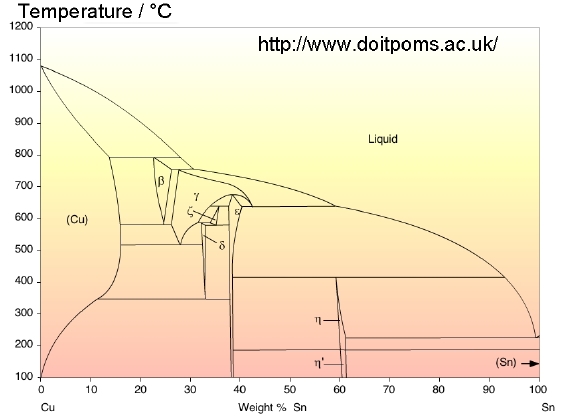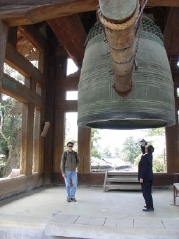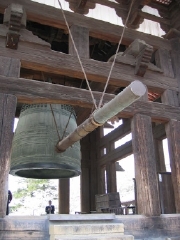

Bronze used for making bells and gongs is essentially an alloy of copper and tin. Copper containing about 22-24 wt% of tin is often known as bell metal because it has a pleasing sound quality when struck.
The chemical composition results in a two-phase microstructure of α (a solid solution of tin in copper, face-centred cubic) and a β (body-centred cubic solid solution of Cu and Sn), when cooled rapidly from 600°C. Slower cooling can result in the precipitation of an embrittling δ phase of composition Cu41Sn11. This is illustrated in the phase diagram below.
 |
The first set of photographs below are taken in South Korea, to illustrate the bell of King Seongdeok, now located at the Gyeongu Museum near Pohang. The bell took about 30 years to achieve. The first casting failed. The second did not give the right sound. A monk then proclaimed that a baby needed to be sacrificed to the melt. The third bell (illustrated) was made in this way. When the bell is struck, its sound at a distance is that of a baby crying for its mother. The veracity of this story is not established.
The following photographs of the Bell of King Seongdeok, courtesy of Professor Hae-Geon Lee

|

|

|

|

|

|

|

|
Photographs courtesy of Thomas Sourmail.

|

|
The T'ongdosa Temple is one of the three famous Bhuddist temples in South Korea. Some of the remains of Buddha are located there.
 Bronze bell |
 |
Shortly after Spain became a democracy, a small section of the army occupied parliament, but King Juan Carlos went on national television in his military attire, and ordered the army to remain in barracks. The coup attempt collapsed.
For single-handedly saving the fledgling democracy in Spain, King Juan Carlos was awarded the highest honour of Cambridge University, an honorary degree.
 Bronze door in Ravello, which is a town and commune situated above the Amalfi Coast in the province of Salerno, Campania, Italy. Photograph courtesy of Professor John Knott. |
 |
 Bronze bell in the railway station in Iguazu, on the border between Argentina and Brazil, within a sub-tropical forest. |
 |
 Bronze birds in Johannesburg |
 Bronze birds in South Africa |
 Bronze birds in Johannesburg |
 Bronze bell at a museum in Dusseldorf |
 Bronze bell at the Max-Planck-Institut für Eisenforschung |
 A cannon made from bronze |
 Near the Kremlin |
| Superalloys | Titanium | Bainite | Martensite | Widmanstätten ferrite |
| Cast iron | Welding | Allotriomorphic ferrite | Movies | Slides |
| Neural Networks | Creep | Mechanicallly Alloyed | Theses | Retained Austenite |
| PT Group Home | Materials Algorithms |